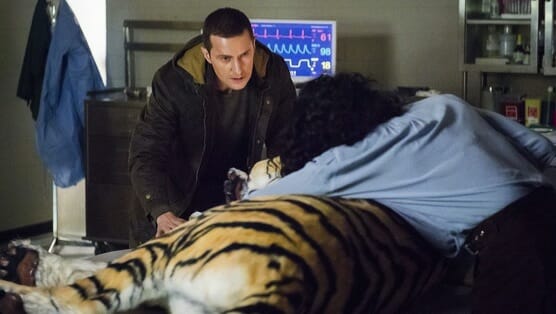Hannibal: “…And the Woman Clothed in Sun”
(Episode 3.10)

Hannibal is a notable program for many reasons. Sure, there’s the well-trodden fact that it’s essentially a premium cable show that somehow snuck its way onto the same network that currently airs the likes of Chicago Fire and The Voice—not to mention how it features the most bizarre, graphic murders ever put on television. But there’s something else beyond these superficial qualities. Namely, Hannibal is one of only a handful of shows to so overtly play with the idea of perception, both in subtle and remarkably unsubtle ways.
“…And the Woman Clothed in Sun” (not to be confused with last week’s “…And the Woman Clothed WITH the Sun”) does a very lovely job at highlighting this notion. From a character standpoint, there’s Dolarhyde, who perceives himself as being grossly deformed, despite the fact that he looks like Richard Armitage and could probably do quite well for himself. There’s Will, who sees himself as having escaped Hannibal’s demented grasp, in spite of the fact that Bedelia spends their entire encounter pointing out how the good doctor still swims around his psyche. Moreover, Hannibal Lecter was originally conceived as almost a satire of the high class—a sophisticated, arts-loving connoisseur who just happened to be a bloodthirsty monster. Beyond character, however, there’s also the fact that Hannibal does more to bend and contort the audience’s conception of reality than any show since Twin Peaks. The later half of Season One, for instance, worked to put viewers inside the mind of Will as he was slowly being driven mad by Hannibal’s treatments. In the process, it became hard to grasp whether the elliptical sequences were all intentional, or if the creative team had simply utterly failed to make their days. Very much intentional, we later learned.
The episode makes its obsessions with perception clear in the first scene, by replaying the conversation that concluded last week’s episode, only this time from Dolarhyde’s perspective. What’s more, Hannibal and Dolarhyde’s intellectual bonding manifests itself, as it does in the Hannibal/Will scenes, with the show exploding any sense of temporal space by allowing the two to appear together in a therapy session. Dolarhyde acts every bit the star-struck fan, explaining that he wants to be the Red Dragon to Hannibal’s “666” monster (aside—a big thank you to the creative team for correctly crediting this to Revelation instead of the oft-misspoken “Revelations”). As the conversation reaches a fever pitch, we see Dolarhyde as he sees himself—a winged, demon-like creature. “Did he who make the Lamb make thee?” Hannibal asks, quoting William Blake’s seminal “The Tyger,” and promptly making the English major in me squeal.
Meanwhile, Will Graham takes a brief break from the Red Dragon case to confront Bedelia, who now appears to be using her European exploits with Hannibal as a means of furthering her career. Following a lecture in which she describes herself as being “swallowed by the Beast,” Will approaches her and scoffs at the façade she’s putting forth. “You’re the Bride of Frankenstein,” he maintains. And, indeed, Will and Bedelia’s subsequent scene reveals that, yes, she is a monster in her own way. When presented with the visual of a helpless bird, for example, Bedelia’s says her immediate reaction is to fulfill her evolution-based nature and squash it. She further coils herself into Will’s mind by blatantly pointing out the homoerotic nature of his and Hannibal’s relationship.
These Will/Bedelia moments mark perhaps the best scenes in an episode chock full of them—not only because of the way in which the two so effectively suss out each other but because their conversation is so expertly intercut with Bedelia’s past session involving Neil (played by Zachary Quinto, in a nice quasi-cameo). As laser-eyed viewers will remember from the season premiere, Neil was the man laying bloodied on the floor of Bedelia’s office when Hannibal arrived to assist her, thus placing her forever in his debt. Here, we learn how this situation came to pass. Neil, it seems, was a former patient of Lecter’s who became alarmed when the doctor began administering highly unconventional methods of treatment, including the same “phototherapy” (putting him in front of a flashing light) that he used on Will in Season One. Neil describes waking up somewhere else and in danger of swallowing his own tongue.
-

-

-

-

-

-

-

-

-

-

-

-

-

-

-

-

-

-

-

-

-

-

-

-

-

-

-

-

-

-

-

-

-

-

-

-

-

-

-

-








































